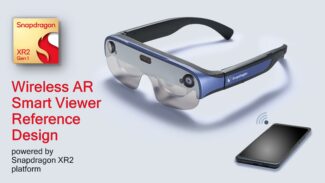Qualcomm showed a new reference design for AR glasses with the XR2 chipset handling a wireless connection to a nearby phone, PC, or processing puck.
Qualcomm says the new “Wireless AR Smart Viewer” design offers a diagonal field of view of around 40 degrees. It’s built by Goertek, the manufacturer used by Meta, Sony, and Pico for their VR headsets. The new glasses design is the latest in a series of headsets from Qualcomm meant to make it easier for the company’s partners to make a product using each design as a reference.

A wired AR Smart Viewer design was announced last year powered by Qualcomm’s older and less expensive XR1 platform. XR2 is the newer, higher priced and more capable chip used to power Quest 2, Vive Focus 3, Pico Neo 3 Link. Qualcomm revealed a reference design for a VR headset based on XR2 back in 2020.
Qualcomm said several manufacturers are exploring the new wireless design which splits rendering and processing tasks between a compatible wireless device and the glasses themselves. Qualcomm claims there’s less than 3 milliseconds of latency between a smartphone and the glasses and the reference design carries a 90Hz refresh rate with 1920 x 1080 resolution per eye from a micro-OLED display.
Quest 2 is so inexpensive at $299 from Meta that the competition is essentially priced out of the consumer market for standalone VR while AR glasses designs offer such a slim field of view that their consumer appeal is fairly limited. That means few companies have taken advantage of these latest reference designs to build consumer products. The ThinkReality A3 smart glasses from Lenovo, for example, were developed in parallel to the XR1-based design and they only target business customers.
XR2 has been shipping in products for a couple years now and we asked Qualcomm’s Hugo Swart if he could offer a timeline for release of a second generation of the chipset. He declined to be specific but told journalists recently they’re “looking for the right time for the next leap in performance.”





